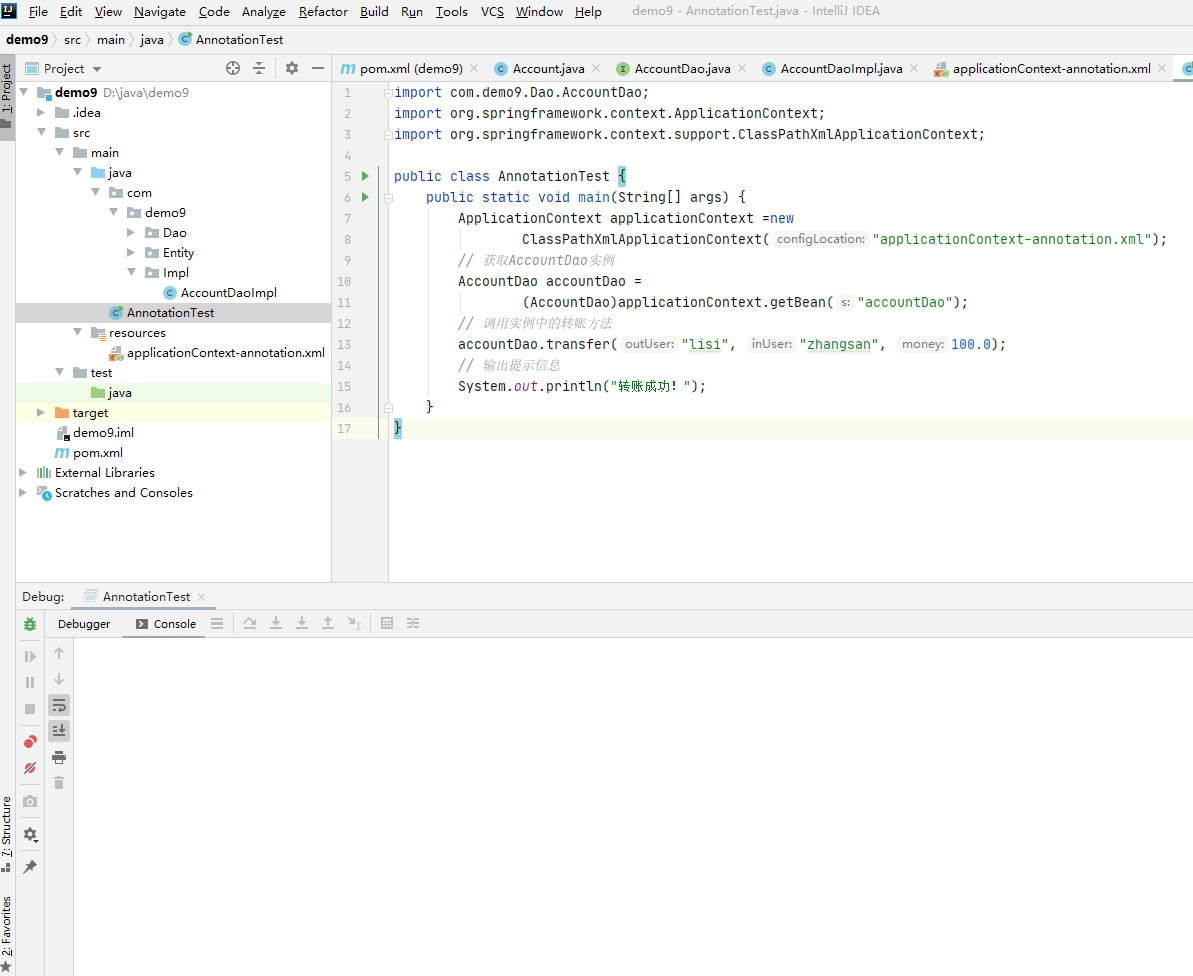本文主要实现基于注解方式的声明式事务,所用工具:
IDEA:2020.2
maven:3.6.3
本文代码下载地址(访问密码: 5321):https://url47.ctfile.com/f/64055047-1501805098-e63549?p=5321
一、创建数据库
打开navicat,执行下面这个sql,创建一个数据库和一个数据表
CREATE DATABASE spring;
USE `spring`;
DROP TABLE IF EXISTS `account`;
CREATE TABLE `account` (
`id` int(11) NOT NULL AUTO_INCREMENT,
`username` varchar(50) DEFAULT NULL,
`balance` double DEFAULT NULL,
PRIMARY KEY (`id`)
) ENGINE=InnoDB AUTO_INCREMENT=5 DEFAULT CHARSET=utf8;
insert into `account`(`id`,`username`,`balance`) values
(1,'zhangsan',100),(3,'lisi',500),(4,'wangwu',300);
执行以后的结果如下:

二、项目搭建
打开IDEA,点击“File—>New—>Project”
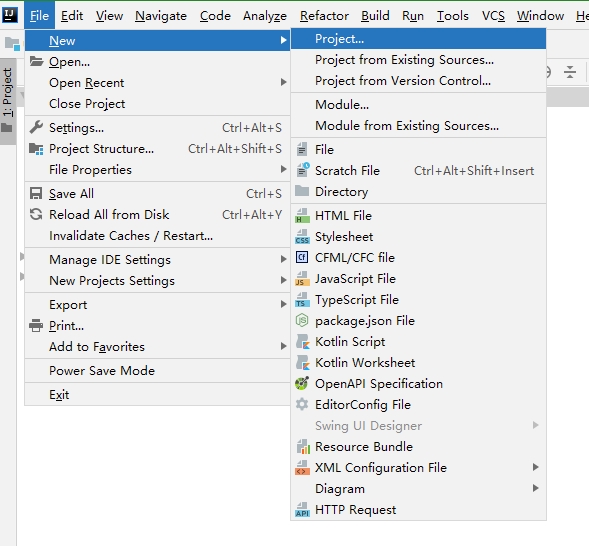
我们 选择“Maven”项目,然后点击“Next”
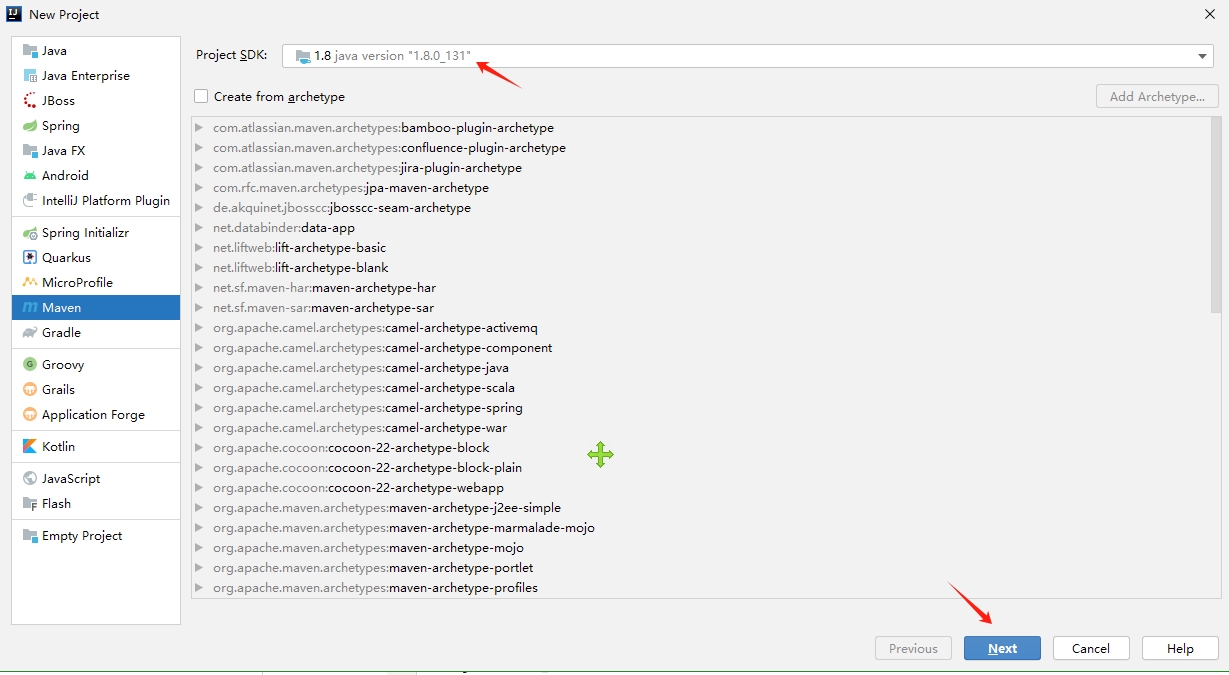
改一下项目名称,然后点击“Finish”

创建完项目默认如下:

打开POM文件,添加相关依赖(注意,要先配置好maven,不然下载不了依赖)
<?xml version="1.0" encoding="UTF-8"?>
<project xmlns="http://maven.apache.org/POM/4.0.0"
xmlns:xsi="http://www.w3.org/2001/XMLSchema-instance"
xsi:schemaLocation="http://maven.apache.org/POM/4.0.0 http://maven.apache.org/xsd/maven-4.0.0.xsd">
<modelVersion>4.0.0</modelVersion>
<groupId>org.example</groupId>
<artifactId>demo9</artifactId>
<version>1.0-SNAPSHOT</version>
<dependencies>
<dependency>
<groupId>org.springframework</groupId>
<artifactId>spring-core</artifactId>
<version>5.2.8.RELEASE</version>
</dependency>
<dependency>
<groupId>org.springframework</groupId>
<artifactId>spring-beans</artifactId>
<version>5.2.8.RELEASE</version>
</dependency>
<dependency>
<groupId>org.springframework</groupId>
<artifactId>spring-aop</artifactId>
<version>5.2.8.RELEASE</version>
</dependency>
<dependency>
<groupId>org.springframework</groupId>
<artifactId>spring-context</artifactId>
<version>5.2.8.RELEASE</version>
</dependency>
<dependency>
<groupId>org.springframework</groupId>
<artifactId>spring-expression</artifactId>
<version>5.2.8.RELEASE</version>
</dependency>
<dependency>
<groupId>commons-logging</groupId>
<artifactId>commons-logging</artifactId>
<version>1.2</version>
</dependency>
<!-- jdbc包 -->
<dependency>
<groupId>org.springframework</groupId>
<artifactId>spring-jdbc</artifactId>
<version>5.2.10.RELEASE</version>
</dependency>
<!-- spring-tx包 -->
<dependency>
<groupId>org.springframework</groupId>
<artifactId>spring-tx</artifactId>
<version>5.2.10.RELEASE</version>
</dependency>
<!-- MySQL数据库驱动 -->
<dependency>
<groupId>mysql</groupId>
<artifactId>mysql-connector-java</artifactId>
<version>8.0.11</version>
<scope>runtime</scope>
</dependency>
<!-- aspectjweaver依赖 -->
<dependency>
<groupId>org.aspectj</groupId>
<artifactId>aspectjweaver</artifactId>
<version>1.9.6</version>
<scope>runtime</scope>
</dependency>
<!-- aopalliance依赖包 -->
<dependency>
<groupId>aopalliance</groupId>
<artifactId>aopalliance</artifactId>
<version>1.0</version>
</dependency>
</dependencies>
</project>如果maven依赖加载没问题,我们就开始创建项目结构。
右击java文件夹,选择New—>Package,

然后分别创建Dao、Entity、Impl这三个文件夹
com.demo9.Entity
com.demo9.Dao
com.demo9.Impl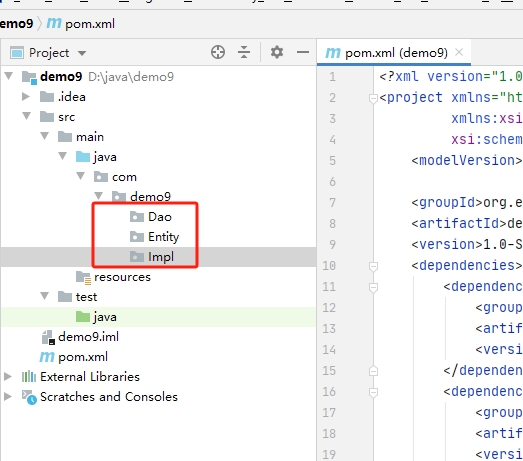
三、编写项目代码
1.编写实体类
右击Entity文件夹,选择New—>Java Class

实体类名称为Account

Account类代码参考如下:
package com.demo9.Entity;
public class Account {
private Integer id; // 账户id
private String username; // 用户名
private Double balance; // 账户余额
public Integer getId() {
return id;
}
public void setId(Integer id) {
this.id = id;
}
public String getUsername() {
return username;
}
public void setUsername(String username) {
this.username = username;
}
public Double getBalance() {
return balance;
}
public void setBalance(Double balance) {
this.balance = balance;
}
public String toString() {
return "Account [id=" + id + ", "
+ "username=" + username +
", balance=" + balance + "]";
}
}2.编写dao层
右击Dao文件夹

名称为AccountDao,注意类型是Interface
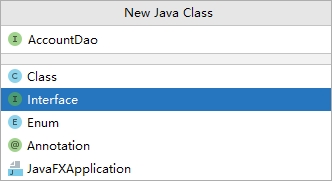
那么代码参考如下:
package com.demo9.Dao;
import com.demo9.Entity.Account;
import java.util.List;
public interface AccountDao {
// 添加
public int addAccount(Account account);
// 更新
public int updateAccount(Account account);
// 删除
public int deleteAccount(int id);
// 通过id查询
public Account findAccountById(int id);
// 查询所有账户
public List<Account> findAllAccount();
// 转账
public void transfer(String outUser,String inUser,Double money);
}3.创建Impl层
右击Impl文件夹,选择New—>Java Class
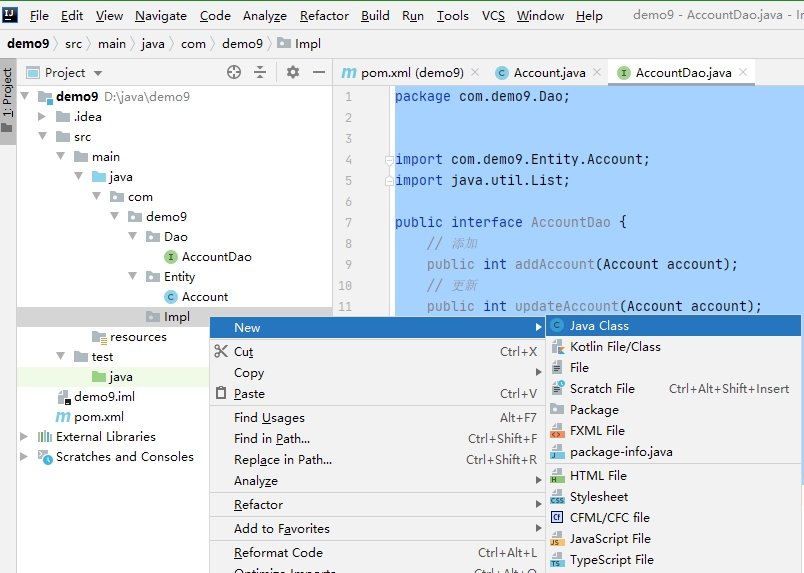
在输入名称处选择 AccountDaoImpl

代码参考如下:
package com.demo9.Impl;
import com.demo9.Dao.AccountDao;
import com.demo9.Entity.Account;
import org.springframework.jdbc.core.BeanPropertyRowMapper;
import org.springframework.jdbc.core.JdbcTemplate;
import org.springframework.jdbc.core.RowMapper;
import org.springframework.transaction.annotation.Isolation;
import org.springframework.transaction.annotation.Propagation;
import org.springframework.transaction.annotation.Transactional;
import java.util.List;
public class AccountDaoImpl implements AccountDao {
// 定义JdbcTemplate属性及其setter方法
private JdbcTemplate jdbcTemplate;
public void setJdbcTemplate(JdbcTemplate jdbcTemplate) {
this.jdbcTemplate = jdbcTemplate;
}
// 添加账户
public int addAccount(Account account) {
// 定义SQL
String sql = "insert into account(username,balance) value(?,?)";
// 定义数组来存放SQL语句中的参数
Object[] obj = new Object[] {
account.getUsername(),
account.getBalance()
};
// 执行添加操作,返回的是受SQL语句影响的记录条数
int num = this.jdbcTemplate.update(sql, obj);
return num;
}
// 更新账户
public int updateAccount(Account account) {
// 定义SQL
String sql = "update account set username=?,balance=? where id = ?";
// 定义数组来存放SQL语句中的参数
Object[] params = new Object[] {
account.getUsername(),
account.getBalance(),
account.getId()
};
// 执行更新操作,返回的是受SQL语句影响的记录条数
int num = this.jdbcTemplate.update(sql, params);
return num;
}
// 删除账户
public int deleteAccount(int id) {
// 定义SQL
String sql = "delete from account where id = ? ";
// 执行删除操作,返回的是受SQL语句影响的记录条数
int num = this.jdbcTemplate.update(sql, id);
return num;
}
// 通过id查询单个账户信息
public Account findAccountById(int id) {
//定义SQL语句
String sql = "select * from account where id = ?";
// 创建一个新的BeanPropertyRowMapper对象
RowMapper<Account> rowMapper =
new BeanPropertyRowMapper<Account>(Account.class);
// 将id绑定到SQL语句中,并通过RowMapper返回一个Object类型的单行记录
return this.jdbcTemplate.queryForObject(sql, rowMapper, id);
}
//查询所有账户信息
public List<Account> findAllAccount() {
// 定义SQL语句
String sql = "select * from account";
// 创建一个新的BeanPropertyRowMapper对象
RowMapper<Account> rowMapper =
new BeanPropertyRowMapper<Account>(Account.class);
// 执行静态的SQL查询,并通过RowMapper返回结果
return this.jdbcTemplate.query(sql, rowMapper);
}
/**
* 转账
* inUser:收款人
* outUser:汇款人
* money:收款金额
*/
@Transactional(propagation = Propagation.REQUIRED,
isolation = Isolation.DEFAULT, readOnly = false)
public void transfer(String outUser, String inUser, Double money) {
// 收款时,收款用户的余额=现有余额+所汇金额
this.jdbcTemplate.update("update account set balance = balance +? "
+ "where username = ?",money, inUser);
// 模拟系统运行时的突发性问题
int i = 1/0;
// 汇款时,汇款用户的余额=现有余额-所汇金额
this.jdbcTemplate.update("update account set balance = balance-? "
+ "where username = ?",money, outUser);
}
}4.编写配置文件
右击resources文件夹,选择New—>File,文件名称写applicationContext-annotation.xml
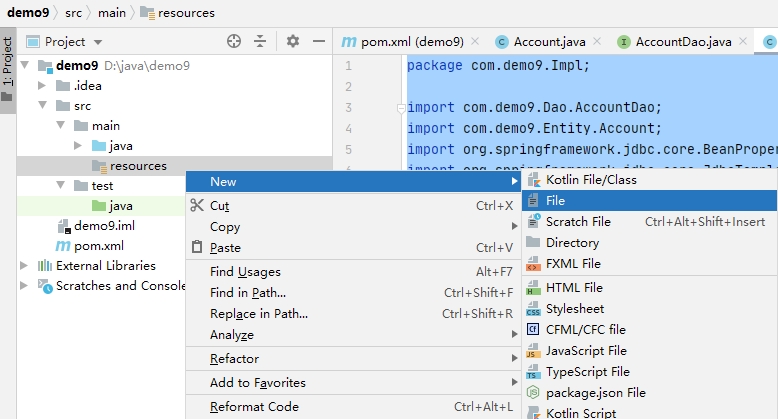
创建好的文件代码参考如下:
注意把数据库密码修改成自己的。
<?xml version="1.0" encoding="UTF-8"?>
<beans xmlns="http://www.springframework.org/schema/beans"
xmlns:xsi="http://www.w3.org/2001/XMLSchema-instance"
xmlns:aop="http://www.springframework.org/schema/aop"
xmlns:tx="http://www.springframework.org/schema/tx"
xmlns:context="http://www.springframework.org/schema/context"
xsi:schemaLocation="http://www.springframework.org/schema/beans
http://www.springframework.org/schema/beans/spring-beans.xsd
http://www.springframework.org/schema/tx
http://www.springframework.org/schema/tx/spring-tx.xsd
http://www.springframework.org/schema/context
http://www.springframework.org/schema/context/spring-context.xsd
http://www.springframework.org/schema/aop
http://www.springframework.org/schema/aop/spring-aop.xsd">
<!-- 1.配置数据源 -->
<bean id="dataSource"
class="org.springframework.jdbc.datasource.DriverManagerDataSource">
<!--数据库驱动 -->
<property name="driverClassName" value="com.mysql.jdbc.Driver" />
<!--连接数据库的url -->
<property name="url" value="jdbc:mysql://localhost/spring?useUnicode=true&characterEncoding=utf-8&serverTimezone=Asia/Shanghai" />
<!--连接数据库的用户名 -->
<property name="username" value="root" />
<!--连接数据库的密码 -->
<property name="password" value="123456" />
</bean>
<!-- 2.配置JDBC模板 -->
<bean id="jdbcTemplate"
class="org.springframework.jdbc.core.JdbcTemplate">
<!-- 默认必须使用数据源 -->
<property name="dataSource" ref="dataSource" />
</bean>
<!--3.定义id为accountDao的Bean -->
<bean id="accountDao" class="com.demo9.Impl.AccountDaoImpl">
<!-- 将jdbcTemplate注入到AccountDao实例中 -->
<property name="jdbcTemplate" ref="jdbcTemplate" />
</bean>
<!-- 4.事务管理器,依赖于数据源 -->
<bean id="transactionManager" class=
"org.springframework.jdbc.datasource.DataSourceTransactionManager">
<property name="dataSource" ref="dataSource" />
</bean>
<!-- 5.注册事务管理器驱动 -->
<tx:annotation-driven transaction-manager="transactionManager"/>
</beans>四、编写测试代码
右击java文件夹,选择New—>Java Class

然后名称为:AnnotationTest
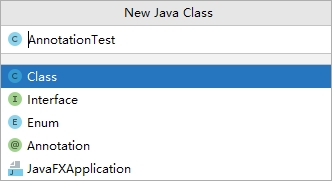
代码参考如下:
import com.demo9.Dao.AccountDao;
import org.springframework.context.ApplicationContext;
import org.springframework.context.support.ClassPathXmlApplicationContext;
public class AnnotationTest {
public static void main(String[] args) {
ApplicationContext applicationContext =new
ClassPathXmlApplicationContext("applicationContext-annotation.xml");
// 获取AccountDao实例
AccountDao accountDao =
(AccountDao)applicationContext.getBean("accountDao");
// 调用实例中的转账方法
accountDao.transfer("lisi", "zhangsan", 100.0);
// 输出提示信息
System.out.println("转账成功!");
}
}五、测试
